Overlooking these common causes of hydraulic system contamination could mean catastrophic machine failure. Vigilance is key in maintaining a clean machine.
By Carl Dyke. CD Industrial Group Inc.
I picture several things when I think of a mobile hydraulic system malfunction:
- damaged control wiring and connectors
- a scored valve spool stuck in place
- a pressure valve poppet kept from closing completely.
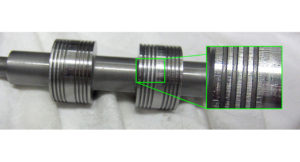
Scoring on this spool due to rust particles (water contamination), caused this valve to stick.
Why do I picture these things? The challenging faults that have triggered a client’s phone call to come and provide hydraulics maintenance training often include these issues. Damaged wiring is the easier of these problems to track down and solve quickly. Harmful particle contaminants are often smaller than what can be seen with the naked eye.
Hydraulic motion control systems—and also hydraulic force control systems (eg. braking systems)—were never meant to circulate a slurry. When insoluble particles are mixed with hydraulic fluid, a slurry is the result. Solids within the liquid are a recipe for trouble. Particles whisked along in high-velocity flows can be driven into clearances causing valves to stick. Hydraulic fluid needs to be pure.
When I was a young boy growing up with logging and lumber mill machinery in the 1970s it wasn’t uncommon to drain the hydraulic oil into a bucket during a hose repair, then pour it right back into the tank once the job was completed. These machines were crude and inefficient with simple gear pumps and direct, lever-operated spool valves. I’m not saying that hydraulic system performance didn’t degrade as grit and sawdust made multiple rounds through the system, but there were no intermittent or catastrophic failures. It was not a great repair process or maintenance culture, but the cost did not have a great impact on the business at the time.
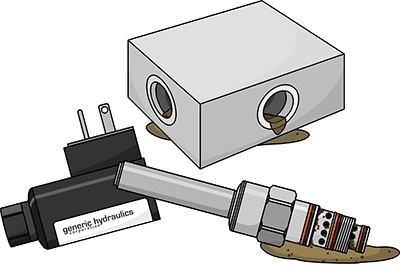
Once hydraulic fluid is badly contaminated, component failures occur more frequently.
Today’s hydraulic systems feature tiny pilot circuits with electronically controlled pressure valves. These pressure-reducing valves produce the precise hydraulic force needed to move a proportional directional valve spool to the desired flow opening. The pilot valves that produce this precise pressure in some cases move less than 1 mm (approx. 3⁄64 in.). The internal parts have close tolerances and are small—often they are on the scale of parts found in a ballpoint pen or a wristwatch. The forces produced by these variable current solenoids are low. These are also valves used as the first layer of hydraulic control in very large construction excavators and mining shovels, or for the steering on a grader. A particle of the right size and shape can jam a pilot valve and render an entire machine inoperable for an extended period of time. Additionally, valves used for safety functions can fail when particles are present. Particles from rust, environmental dust as well as slivers of wear metals need to be removed from the fluid if the system is expected to perform reliably.
How does contamination get into a system?
Common contamination ingression paths include the following:
- When filling with new fluid
- Quick couplers
- Through the breather
- Cylinder rod scratches
- Bad top-of-tank gaskets
- Exposed ports during repair
- Worn seals
- Brand new hydraulic fluid
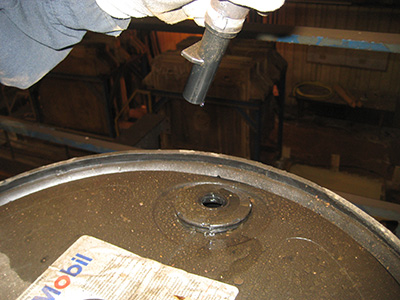
Careless drum storage can introduce contamination at the source.
How do these contaminants get inside? There are numerous ingression paths. Some of these particles are even manufactured on the inside of a hydraulic system. Water is a common liquid contaminant that assists in the creation of extremely hard, iron oxide particles right where a rust patch forms inside a valve.
Sometimes a jug/drum/tote with new fluid is already contaminated. This is either because the bottling or filling plant itself was dirty, the container it has been stored in was dirty, or because the container has been contaminated by multiple careless openings and closings.
A careless filling procedure without proper filtration and cleaning will drag contaminants into the system along with the new oil. The old practice of using an open pail and funnel to fill a hydraulic reservoir should remain in the past if reliable performance is the goal. Much better methods for filling are available that use a filter-transfer pump to draw fluid from a barrel or tote and pump it directly into the reservoir through a coupler on the side of the tank.
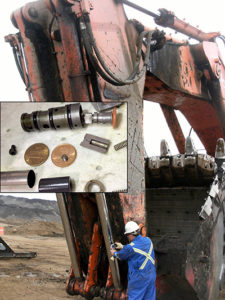
These little, tiny components are integral to the operation of this massive shovel.
Older style breather/filler caps have very porous mesh (40 microns and larger is typical). They are not up to the task of keeping contamination out. If someone has been shortcutting the filling process by dumping fresh fluid in through the breather port, it becomes an excellent entry point for contamination.
Quick couplers are found on machines as test points, accessory attachments, and tank filling points. If they are not absolutely spotless before a connection is made, contaminants are directly forced into the system.
In my experience the five most common solid particle types found in the fluid of a hydraulic system are:
- Metals
- Silica
- Elastomers
- Fibers
- Rust
Metal particles are common
Metal particles enter a hydraulic system when wire reinforced hose is cut to length with an abrasive wheel just before crimped fittings are attached. A practice that is growing in popularity and that should be considered a standard is to have all hose assemblies cleaned using a compressed-air-driven cleaning projectile before installation.
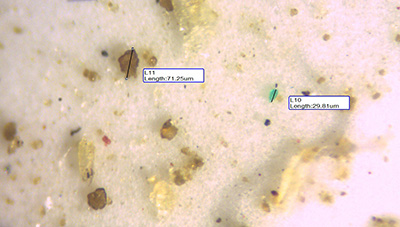
Many particles such as the 30 micron, green mineral particle shown, can’t be seen without a microscope.
Filings from drilling, threading and fabricating a metal hydraulic tank are common. Metal fragments are also created when moving parts come in direct contact with each other. This is common in pumps and valves when the hydraulic oil viscosity is too thin. The outlet port pressure of a gear pump will often drive the hardened gears against the inlet side of the housing, causing scuffing and creating aluminum or steel shavings. Some mobile lift machines with long-stroke cylinders that have cycled past their expected service life may produce metal slivers and filings as the piston scrubs against the inside of the cylinder. This is true where the internal stop tube is of insufficient length.
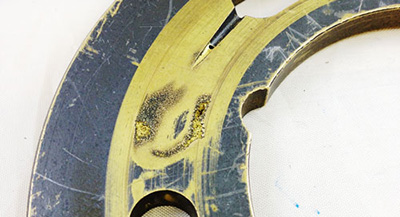
Cavitation has scattered bits of metal ripped from this porting plate throughout the hydraulic system.
A pump that suffers from cavitation will also generate metal particles. Excessive restriction to flow on the inlet side of the pump creates vapor cavities which implode near the high-pressure outlet. During the implosion, the resulting shock wave damages metal surfaces and tears out small particles. The softer metals inside a pump—such as bronze or aluminum—are most prone to this erosion damage. Harder materials such as steel can also suffer this erosion damage, as happens when a runaway cylinder under negative load creates an extremely low-pressure zone on the outlet of a partially open, flow or directional valve. Some researchers have found that the presence of solid particles in hydraulic oil makes it even easier for cavitation bubbles to form.
Metal particles that remain in suspension can cause additional erosion as they strike against valve spool metering notches and valve port edges during the high-velocity flow that occurs as a valve is first opening, or just before it closes.
Upon the study of metal particle damage alone and the runaway effects that can occur, one can see how important it is to keep hydraulic fluid clean and the forces of cavitation at bay.
Prevent plugs from soft fibers
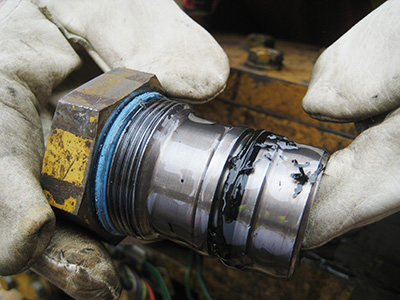
The seal damaged due to cavitation may mean internal leakage as well as intermittent faults.
Fibers from wood, cardboard, paper, shop towels and rags are commonly found in hydraulic system fluids. Elastomer contaminant particles come from hoses, O-rings and seals when they break down. While these are softer contaminant types, they can easily plug a control or damping orifice. Tiny silica particles (silicon dioxide) are commonly found in topsoil. Quartz rock sand is silica. Other rock minerals and dust on a concrete floor or roadway also contain silica. These hard, sharp-edged particles cause catastrophic valve failures to the mobile machinery that operates in these conditions.
Filters are not meant to compensate for poor overall maintenance practices where little attempt is being made to operate a system correctly and keep its surroundings as clean as reasonably possible. If hydraulic fluid analysis reports continuously show excessive particle levels for a given system, it can be helpful to enlist the help of an independent filtration and contamination control expert who can identify the source of the contaminants, help design improved maintenance practices or select and specify more effective filtration products and systems.
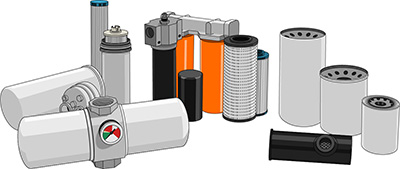
Filters are designed to help maintain fluid cleanliness, not to compensate for poor operations and maintenance practices.
It is inevitable that some contaminants will find their way into a hydraulic system. To achieve reliable hydraulic system performance, it is important to find methods to control contamination build-up, and then follow them consistently, even after the contamination control expert has left the site.
It is easy to overlook periods of overheated system operation and forget that these periods may help to create a sludge within the fluid or cause excessive metal-to-metal wear when heat has made the oil too thin. The complete picture of contamination control requires vigilance, collaboration and ownership from all who interact with any hydraulic system. Machine operators are commonly tasked with performing filter changes or replacing worn hydraulic hoses. Often the training they receive (if any), and the instructions in the maintenance manual cover only the minimum steps related to the task, without regard for your contamination control strategies. Raising awareness of the consequences of excessive fluid contamination can play a vital role in achieving reliable hydraulic system performance.
While there certainly are technical aspects to understanding and controlling fluid contamination, operational and maintenance practice brings the cultural and human factor to the forefront to make the most important contribution.
CD Industrial Group
carldyke.com
LunchBoxSessions.com
Filed Under: Mobile Hydraulic Tips, Slider